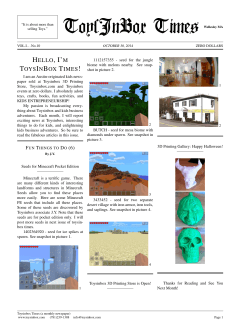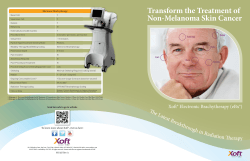
Improving Brachytherapy Treatments for Cancer Patients Using
Contact: Jade Terry / Andrew King HKA Marketing Communications 714-426-0444 jade@hkamarcom.com / andrew@hkamarcom.com FOR IMMEDIATE RELEASE Improving Brachytherapy Treatments for Cancer Patients Using Platform Nanotechnology Ashland, Mass., March 19, 2015 – BioSurfaces, Inc., the parent company of NuVascular Technologies, Inc., has partnered with Florida-based cancer-treatment company Microspherix, LLC to improve the effectiveness and reduce the risk of brachytherapy treatment for patients affected by prostate, breast, brain and other cancers. These improvements should make this cost-effective treatment more attractive for a wider range of patients. Permanent brachytherapy is an internal radiation therapy that places radioactive material directly into or near cancerous tumors, delivering more radiation to a smaller area compared to traditional external radiation. Radioactive material is placed directly into small hollow metallic carrier rods, or “seeds,” which are then inserted through delivery needles into cancers. The procedure can be used alone or in combination with other therapies such as surgery, external radiation and/or chemotherapy. There are two major weaknesses with the current system: seeds A metallic brachytherapy seed positioned on a can be diverted, or migrate, away from the intended thumb, demonstrating the small size of the delivery site, and seed location cannot be adequately device. Radioisotope-coated seeds are detected by the best imaging techniques, such as injected near the tumor using needles. magnetic resonance imaging (MRI). Microspherix is applying BioSurfaces’ nanotechnology to its patented brachytherapy seed exterior that prevents seeds from migrating due to an irregular, rather than smooth, surface contour. The nanotechnology is captured in a sheath that not only allows seeds to keep their position, but also enables them to be imaged by an MRI due to the presence of a commonly used MRI-agent carried by the nanofibrous matrix from BioSurfaces. Migration of individual radioactive seeds away from their intended target inadvertently occurs when seeds bobsled along the needle insertion tract or enter the circulation after an insertion needle nicks a vessel. Exposure to wayward seeds can result in damage to non-cancerous tissue. The smooth surface and small size of the radioactive seeds can enable them to travel through the bloodstream until they are trapped in organs such as the lungs. Perhaps more importantly, migration can dilute the planned dose to the target by diverting seeds elsewhere. Development of technology to detect seed location and prevent migration has been limited to biodegradable coatings, until now. BioSurfaces' non-degradable nanofibrous sheath, which can be easily and rapidly applied onto any existing brachytherapy seed, permits MRI detection and prevents seed migration. “Brachytherapy has been around for decades, but the lack of visibility on imaging and the possibility of seed movement have lessened the potential of this highly-effective therapy,” said Matthew Phaneuf, noted biomaterial researcher as well as president and CTO of BioSurfaces. “We are confident that this technology will amplify brachytherapy’s uses and provide a costeffective way to improve patient outcomes.” There are currently more than 14 million cancer cases worldwide, a number that is projected to exceed 24 million by 2030. By then, the brachytherapy market is expected to rise in value to $2.4 billion. A nanofibrous sheath with a crimped structure and MRI agent throughout the matrix was placed onto a metallic seed as shown by light microscopy at 65X (left). Assessment of the sheath using scanning electron microscopy at 85X magnification showed an accordion-like structure with a nanofibrous composition that was consistent throughout (right). “I am confident that this technology will improve the standard of care in the field of radiation oncology, and remove the disconnect between cancer treatments and accurate imaging,” said Dr. Edward Kaplan, board certified radiation oncologist and founder of Microspherix. “Now, routine use of MRI with permanent brachytherapy will raise physicians’ confidence levels, knowing that their tumor targets are fully implanted, without any holes in the intended dose cloud. This is the first time this technology has been developed anywhere.” About NuVascular Technologies and BioSurfaces: NuVascular Technologies, Inc. was established in Ashland, Mass., in 2014. The company was formed to commercialize patented technology developed over the past decade by BioSurfaces, Inc. and to further develop next-generation nanotechnology. Under the direction of an experienced management team and scientific advisory board, the company is developing medical solutions that mimic natural tissue growth and incorporate targeted drug delivery. About Microspherix LLC: Microspherix LLC is a closely held biotechnology start-up based in Boca Raton, Fla., established in 2001 by physician-scientist, Dr. Edward J. Kaplan. The company has an extensive patent portfolio related to brachytherapy as well as the emerging field of entotherapy. The latter is focused on local delivery of image-guided drug-eluting seed implants. Microspherix is currently sponsoring a pilot trial of its first entotherapy product at a renowned veterinary college in the United States. ###
© Copyright 2025











